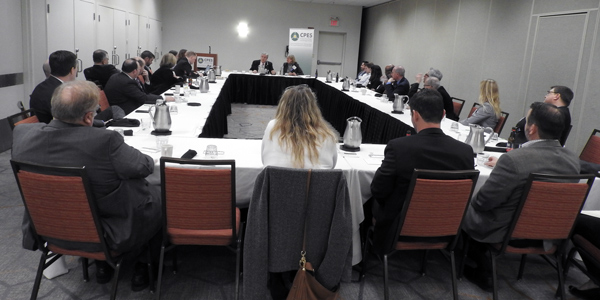By Michael Kuser
CROMWELL, Conn. — State officials last week shared their musings on a range of subjects, including the state’s energy agenda, regulatory woes and China’s approach to siting nuclear plants.
At a March 14 meeting of the Connecticut Power & Energy Society, Eric Johnson — the group’s president and director of external affairs for ISO-NE — introduced the speakers a day after New England had been hit by its third nor’easter in two weeks.
“I see some weary utility people in the room who have been pulling storm duty and lines-down duty perhaps,” Johnson said. “I know in our house, folks are ready for spring.”
Jack Betkoski, vice chairman of the Public Utilities Regulatory Authority, noted his agency will hold its first technical conference on grid modernization April 3 and also has a docket open on the nationwide issue of tax reform.
The PURA continues “to look into best practices of electric suppliers,” he said. “We continue to work hard and cooperatively with the companies that come up with procedures that will make life easier for the companies and also make life easier for us as the regulatory agency.”
Regulatory Independence
Betkoski also pointed to a state-level trend around the country to “blow up” regulatory agencies, citing situations in South Carolina, where the House of Representatives has voted to fire the seven-member Public Service Commission after the abandonment of constructing two units at the V.C. Summer nuclear plant, and Tennessee, where the government changed the structure of the Regulatory Authority — now the Public Utility Commission — with regulators now working part-time.
People need to be educated that “we’re kind of like judges, and we need to be independent,” Betkoski said. “The legislature … serves a great purpose and comes up with great tools for us to work with, but you still have to maintain the independence of the regulatory body and the legislative body. I think that’s imperative, and when that starts to be compromised I don’t think anybody wins.”
Soon after becoming NARUC president last August, Betkoski went to China and Japan to see their coal-fired and nuclear plants.
“China has an interesting way of siting their nuclear plants: They just take over a whole town and say this is the way it’s happening,” Betkoski said. “I said, ‘What was here before?’ A town. They’ve got five nuclear plants now and that’s just the way they do it over there.”
Comprehensive Energy Strategy

Tracy Babbidge, head of energy and technology policy for the state’s Department of Energy and Environmental Protection, provided an update on the Comprehensive Energy Strategy (CES) released last month.
Babbidge said the strategy is intended to be comprehensive without getting too far into the details. “We’re trying get to the point and also trying to cover every topic,” she said.
Among other things, the plan calls for increasing the state’s renewable portfolio standard to 40% of total electric usage by 2030, from 24% in 2018. Environmentalists protested the plan’s emphasis on natural gas as a clean resource, and University of Connecticut students rallied outside the capitol in Hartford last month to push the state to support more renewables.
The CES recommends that Babbidge’s division of DEEP increase its engagement with other states and regional organizations to help shape policy at FERC and ISO-NE.
In addition, the plan recommends the state streamline permitting and siting and work to make the average cost of solar PV installations fall below residential rates, and that DEEP monitor waste-to-energy facilities as long-term power purchase agreements expire and operating costs increase.
“One of the big themes is ensuring sustainable and equitable funding for energy efficiency,” Babbidge said. “This really speaks to the legislative diversions, and they need to make sure that [for] our clean energy programs, both on the efficiency side and the Green Bank, that the funding is secure.”







